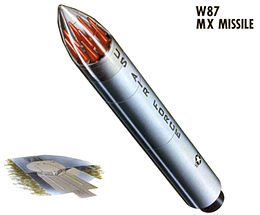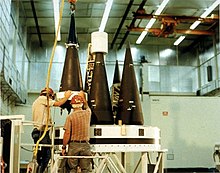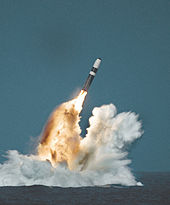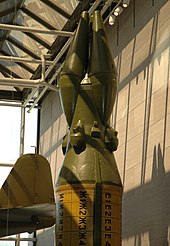Multiple independently targetable reentry vehicle
This articleneeds additional citations forverification.(June 2014) |




Amultiple independently targetable reentry vehicle(MIRV) is anexoatmosphericballistic missilepayload containing severalwarheads,each capable of being aimed to hit a different target. The concept is almost invariably associated withintercontinental ballistic missilescarryingthermonuclear warheads,even if not strictly being limited to them. An intermediate case is themultiple reentry vehicle(MRV) missile which carries several warheads which are dispersed but not individually aimed. Allnuclear-weapon statesexceptPakistan[a]andNorth Korea[b]are currently confirmed to have deployed MIRV missile systems.Israelis suspected to possess or be in the process of developing MIRVs.[citation needed]
The first true MIRV design was theMinuteman III,first successfully tested in 1968 and introduced into actual use in 1970.[5][6][7]The Minuteman III held three smallerW62warheads, with yields of about 170 kilotons of TNT (710 TJ) each in place of the single 1.2 megatons of TNT (5.0 PJ)W56used on the Minuteman II.[8]From 1970 to 1975, the United States would remove approximately 550 earlier versions of the Minuteman ICBM in theStrategic Air Command's (SAC) arsenal and replace them with the new Minuteman IIIs outfitted with a MIRV payload, increasing their overall effectiveness.[6]The smaller power of the warheads used (W62, W78 and W87) was offset by increasing the accuracy of the system, allowing it to attack the same hard targets as the larger, less accurate, W56.[8][9]The MMIII was introduced specifically to address the Soviet construction of ananti-ballistic missile(ABM) system around Moscow; MIRV allowed the US to overwhelm any conceivable ABM system without increasing the size of their own missile fleet. The Soviets responded by adding MIRV to theirR-36design, first with three warheads in 1975, and eventually up to ten in later versions. While the United States phased out the use of MIRVs in ICBMs in 2014 to comply withNew START,[10]Russia continues to develop new ICBM designs using the technology.[11]
The introduction of MIRV led to a major change in the strategic balance. Previously, with one warhead per missile, it was conceivable that one could build a defense that used missiles to attack individual warheads. Any increase in missile fleet by the enemy could be countered by a similar increase in interceptors. With MIRV, a single new enemy missile meant that multiple interceptors would have to be built, meaning that it was much less expensive to increase the attack than the defense. Thiscost-exchange ratiowas so heavily biased towards the attacker that the concept ofmutual assured destructionbecame the leading concept in strategic planning and ABM systems were severely limited in the 1972Anti-Ballistic Missile Treatyin order to avoid a massivearms race.
In June 2017 the United States finished converting its Minuteman III missiles back to using a single reentry vehicle system, as part of its obligations under theNew STARTtreaty.[12][13]
Purpose
[edit]The military purpose of a MIRV is fourfold:
- Enhancefirst-strikeproficiency for strategic forces.[14]
- Providing greater target damage for a giventhermonuclear weaponpayload. Several small and lower yield warheads cause much more target damage area than a single warhead alone. This, in turn, reduces the number of missiles and launch facilities required for a given destruction level – much the same as the purpose of acluster munition.[15]
- With single-warhead missiles, one missile must be launched for each target. By contrast, with a MIRV warhead, the post-boost (or bus) stage can dispense the warheads against multiple targets across a broad area.
- Reduces the effectiveness of ananti-ballistic missilesystem that relies on intercepting individual warheads.[16]While a MIRV attacking missile can have multiple warheads (3-12 on United States and Russian missiles, or 14 in a maximum payload shorter-range configuration of theTrident IInow barred by START), interceptors may have only one warhead per missile. Thus, in both a military and an economic sense, MIRVs render ABM systems less effective, as the costs of maintaining a workable defense against MIRVs would greatly increase, requiring multiple defensive missiles for each offensive one. Decoyre-entryvehicles can be used alongside actual warheads to minimize the chances of the actual warheads being intercepted before they reach their targets. A system that destroys the missile earlier in its trajectory (before MIRV separation) is not affected by this but is more difficult, and thus more expensive to implement.
MIRV land-basedICBMswere considered destabilizing because they tended to put a premium onstriking first.[17]The world's first MIRV—USMinuteman IIImissile of 1970—threatened to rapidly increase the US's deployable nuclear arsenal and thus the possibility that it would have enough bombs to destroy virtually all of theSoviet Union's nuclear weaponsand negate any significant retaliation. Later on the US feared the Soviet's MIRVs because Soviet missiles had a greaterthrow-weightand could thus put more warheads on each missile than the US could. For example, the US MIRVs might have increased their warhead per missile count by a factor of 6 while the Soviets increased theirs by a factor of 10. Furthermore, the US had a much smaller proportion of its nuclear arsenal in ICBMs than the Soviets. Bombers could not be outfitted with MIRVs so their capacity would not be multiplied. Thus the US did not seem to have as much potential for MIRV usage as the Soviets. However, the US had a larger number ofsubmarine-launched ballistic missiles,which could be outfitted with MIRVs, and helped offset the ICBM disadvantage. It is because of their first-strike capability that land-based MIRVs were banned under theSTART IIagreement. START II was ratified by theRussian Dumaon 14 April 2000, but Russia withdrew from the treaty in 2002 after the US withdrew from theABM treaty.
Operation
[edit]In a MIRV, the main rocket motor (orbooster) pushes a "bus" into a free-flightsuborbitalballistic flight path. After the boost phase, the bus maneuvers using small on-board rocket motors and a computerizedinertial guidance system.It takes up a ballistic trajectory that will deliver a re-entry vehicle containing a warhead to a target and then releases a warhead on that trajectory. It then maneuvers to a different trajectory, releasing another warhead, and repeats the process for all warheads.

The precise technical details are closely guardedmilitary secrets,to hinder any development of enemy counter-measures. The bus's on-boardpropellantlimits the distances between targets of individual warheads to perhaps a few hundred kilometers.[18]Some warheads may use smallhypersonicairfoilsduring the descent to gain additional cross-range distance. Additionally, some buses (e.g. theBritishChevalinesystem) can releasedecoysto confuse interception devices andradars,such asaluminizedballoons or electronic noisemakers.

Accuracy is crucial because doubling the accuracy decreases the needed warhead energy by a factor of four for radiation damage and by a factor of eight for blast damage. Navigation system accuracy and the available geophysical information limits the warhead target accuracy. Some writers believe[weasel words]that government-supported geophysical mapping initiatives and ocean satellite altitude systems such asSeasatmay have a covert purpose to map mass concentrations and determine localgravity anomalies,in order to improve accuracies of ballistic missiles.[citation needed]Accuracy is expressed ascircular error probable(CEP). This is the radius of the circle that the warhead has a 50 percent chance of falling into when aimed at the center. CEP is about 90–100 m for theTrident IIandPeacekeepermissiles.[19]
MRV
[edit]A multiple re-entry vehicle (MRV) system for aballistic missiledeploys multiple warheads above a single aimpoint which then drift apart, producing a cluster bomb-like effect. These warheads are not individually targetable. The advantage of an MRV over a single warhead is the increased effectiveness due to the greater coverage; this increases the overall damage produced within the center of the pattern, making it far greater than the damage possible from any single warhead in the MRV cluster; this makes for an efficient area-attack weapon and makes interception byanti-ballistic missilesmore challenging due to the number of warheads being deployed at once.[6]
Improved warhead designs allow smaller warheads for a given yield, while better electronics and guidance systems allow greater accuracy. As a result, MIRV technology has proven more attractive than MRV for advanced nations. Multiple-warhead missiles require both a miniaturizedphysics packageand a lower mass re-entry vehicle, both of which are highly advanced technologies. As a result, single-warhead missiles are more attractive for nations with less advanced or less productive nuclear technology. The United States first deployed MRV warheads on thePolaris A-3SLBMin 1964 on theUSS Daniel Webster.ThePolaris A-3missile carried three warheads each having an approximate yield of 200 kilotonnes of TNT (840 TJ). This system was also used by the Royal Navy who also retained MRV with theChevalineupgrade, though the number of warheads in Chevaline was reduced to two due to the ABM counter-measures carried.[6]The Soviet Union deployed 3 MRVs on theR-27USLBM and 3 MRVs on theR-36PICBM. Refer toatmospheric re-entryfor more details.
MIRV-capable missiles
[edit]- DF-3A(retired, 3 warheads)
- DF-4A(retired, 3 warheads)
- DF-5B(active, 3-8 warheads)
- DF-5C(active, 10 warheads)
- DF-31A(active, 3-5 warheads)
- DF-31B(active, 3-5 warheads)
- DF-41(active, up to 10 warheads)
- JL-2(active, 1-3 warheads)
- JL-3(under development)
- Agni-V[20](active, 3-6 (tested)[21][22]10–12 (Operational)[23]nuclear warheads)
- Agni Prime[24](active, 2 warheads)
- Agni-VI[25](under development)
- K-6[26](under development)

- R-36 mod 4(retired, 10-14 warheads)
- R-36 mod 5(active, 10 warheads)
- R-29R(active, 3 warheads)
- R-29RK(retired, 7 warheads)
- MR-UR-100 Sotka(retired, 4 warheads)
- UR-100Nmod 3 (retired, 6 warheads)
- RSD-10 Pioneer(retired, 3 warheads)
- R-39 Rif(retired, 10 warheads)
- R-29RM Shtil(retired, 4 warheads)
- RT-23 Molodets(retired, 10 warheads)
- R-29RMU Sineva(active, 4 or 10 warheads)
- RS-24 Yars(active, 3-4 warheads)
- R-29RMU2 Layner(active, 4 or 12 warheads)
- RSM-56 Bulava(active 6-10 warheads)
- RS-28 Sarmat(active, 10-15 warheads)
- RS-26 Rubezh(development stopped, 4 warheads)
- BZhRK Barguzin(development stopped, 4-16 warheads)
- UGM-133 Trident II(active, 8-14 warheads)
- LGM-30 Minuteman III(active, 1-3 warheads, currently carries one warhead)
- UGM-73 Poseidon(retired, 10 or 14 warheads)
- UGM-96 Trident I(retired, 8 warheads)
- LGM-118 Peacekeeper(retired, 10 warheads)
- UGM-133 Trident II(active 8-14 warheads)
See also
[edit]- Comparison of ICBMs
- DARPA Falcon Project
- List of ICBMs
- Maneuverable re-entry vehicle(MARV or MaRV)
- Missile Command—1980s video game in which MIRVs must be intercepted
- Multiple Kill Vehicle
Notes
[edit]References
[edit]- Notes
- ^Parsch, Andreas."UGM-133".Directory of U.S. Military Rockets and Missiles.Archivedfrom the original on 2011-03-15.Retrieved2014-06-13.
- ^"Statement for the Record: Worldwide Threat Assessment".March 6, 2018. Archived fromthe originalon 2018-03-13.RetrievedMarch 31,2024.
- ^abUsman Haider; Abdul Moiz Khan (18 November 2023)."Why Did Pakistan Test Its MIRV-Capable Ababeel Missile?".The Diplomat.Retrieved11 March2024.
- ^"North Korea Says it Successfully Conducted Multiple Warhead Missile Test".NKNews.27 June 2024.Retrieved26 June2024.
- ^"Military says Minuteman missiles ready".Lewiston Morning Tribune.(Idaho). Associated Press. July 20, 1970. p. 1.Archivedfrom the original on August 28, 2020.RetrievedMay 31,2020.
- ^abcdPolmar, Norman;Norris, Robert S. (1 July 2009).The U.S. Nuclear Arsenal: A History of Weapons and Delivery Systems since 1945(1st ed.).Naval Institute Press.ISBN978-1557506818.LCCN2008054725.OCLC602923650.OL22843826M.
- ^"The Minuteman III ICBM".Archivedfrom the original on 2019-01-18.Retrieved2017-09-17.
- ^ab"Nuclear Chronology"(PDF).acq.osd.mil.July 2021.Archived(PDF)from the original on August 12, 2022.RetrievedJanuary 18,2024.
- ^"W87-1 Modification Program"(PDF).energy.gov.March 1, 2019.Archived(PDF)from the original on March 26, 2023.RetrievedJanuary 18,2024.
- ^"Last Malmstrom ICBM reconfigured under treaty".Great Falls Tribune.Archivedfrom the original on 2020-08-28.Retrieved2018-09-08.
- ^"Putin has touted an 'invincible' nuclear weapon that really exists — here's how it works and why it deeply worries experts".Business Insider.Archivedfrom the original on 2018-09-08.Retrieved2018-09-08.
- ^"The End of MIRVs for U.S. ICBMs".The Equation.2014-06-27.Retrieved2024-01-19.
- ^"NMHB 2020 [Revised]".acq.osd.mil.Retrieved2024-01-19.
- ^Buchonnet, Daniel (1 February 1976)."MIRV: A BRIEF HISTORY OF MINUTEMAN and MULTIPLE REENTRY VEHICLES".gwu.edu.Lawrence Livermore Laboratory.United States Department of Defense.Archivedfrom the original on 15 September 2019.Retrieved24 November2019.
The idea of multiple warheads dates back to the mid-1960s, but the key year in the history of the MIRV concept was 1962 when several of technological developments made it possible for scientists and engineers to conceive of multiple, separately targeted warheads that could hit a growing list of Soviet nuclear threat targets. One important innovation was that the weapons laboratories had designed small thermonuclear weapons, a necessary condition for deploying multiple reentry vehicles on the relatively small Minuteman.
- ^The best overall printed sources on nuclear weapons design are:Hansen, Chuck.U.S. Nuclear Weapons: The Secret History.San Antonio, TX: Aerofax, 1988; and the more-updated Hansen, Chuck, "Swords of Armageddon: U.S. Nuclear Weapons Development since 1945Archived2016-12-30 at theWayback Machine"(CD-ROM & download available). PDF. 2,600 pages, Sunnyvale, California, Chukelea Publications, 1995, 2007.ISBN978-0-9791915-0-3(2nd Ed.)
- ^Robert C. Aldridge (1983).First Strike!: The Pentagon's Strategy for Nuclear War.South End Press. pp. 65–.ISBN978-0-89608-154-3.Archivedfrom the original on 16 July 2014.Retrieved26 February2013.
- ^Heginbotham, Eric (15 March 2017)."China's Evolving Nuclear Deterrent: Major Drivers and Issues for the United States".Archivedfrom the original on 2017-12-01.Retrieved2017-12-01.
- ^"Question Re Mirv Warheads — Military Forum | Airliners.net".Archivedfrom the original on 2007-10-16.Retrieved2008-07-02.
- ^Cimbala, Stephen J. (2010).Military Persuasion: Deterrence and Provocation in Crisis and War.Penn State Press. p. 86.ISBN978-0-271-04126-1.Archivedfrom the original on 26 April 2016.Retrieved3 May2013.
- ^"India conducts first test flight of domestically developed missile that can carry multiple warheads".apnews.11 March 2024.
- ^"India's MIRV-tipped Agni-5 Missile Test: All your questions answered".Business Standard.
- ^"One missile, many weapons: What makes the latest Agni-5 special".The Indian Express.2024-03-12.Retrieved2024-03-14.
- ^"Why India Testing Agni-5 is a Milestone Moment".News18.2024-03-12.Retrieved2024-03-14.
- ^Rout, Hemant Kumar (2021-09-13)."India to conduct first user trial of Agni-V missile".The New Indian Express.Retrieved2024-03-12.
- ^"Mission Divyastra successful: A look at evolution of Agni missiles".India Today.Retrieved2024-03-12.
- ^Gady, Franz-Stefan."India Launches Second Ballistic Missile Sub".thediplomat.Retrieved2024-03-12.
- ^"Jericho 3".Missile Threat.Center for Strategic and International Studies.Archivedfrom the original on 21 January 2013.Retrieved4 April2020.
- ^"Pakistan missile test confirms its MIRV ambitions".IISS.Retrieved2024-04-04.
External links
[edit]- "MIRV: A BRIEF HISTORY OF MINUTEMAN and MULTIPLE REENTRY VEHICLES"by Daniel Buchonnet, Lawrence Livermore Laboratory, February 1976.
- Operation 1964
- The Defense of the United States, 1981 CBS Five-Part TV SeriesArchived2011-06-07 at theWayback MachinefromGoogle Video
